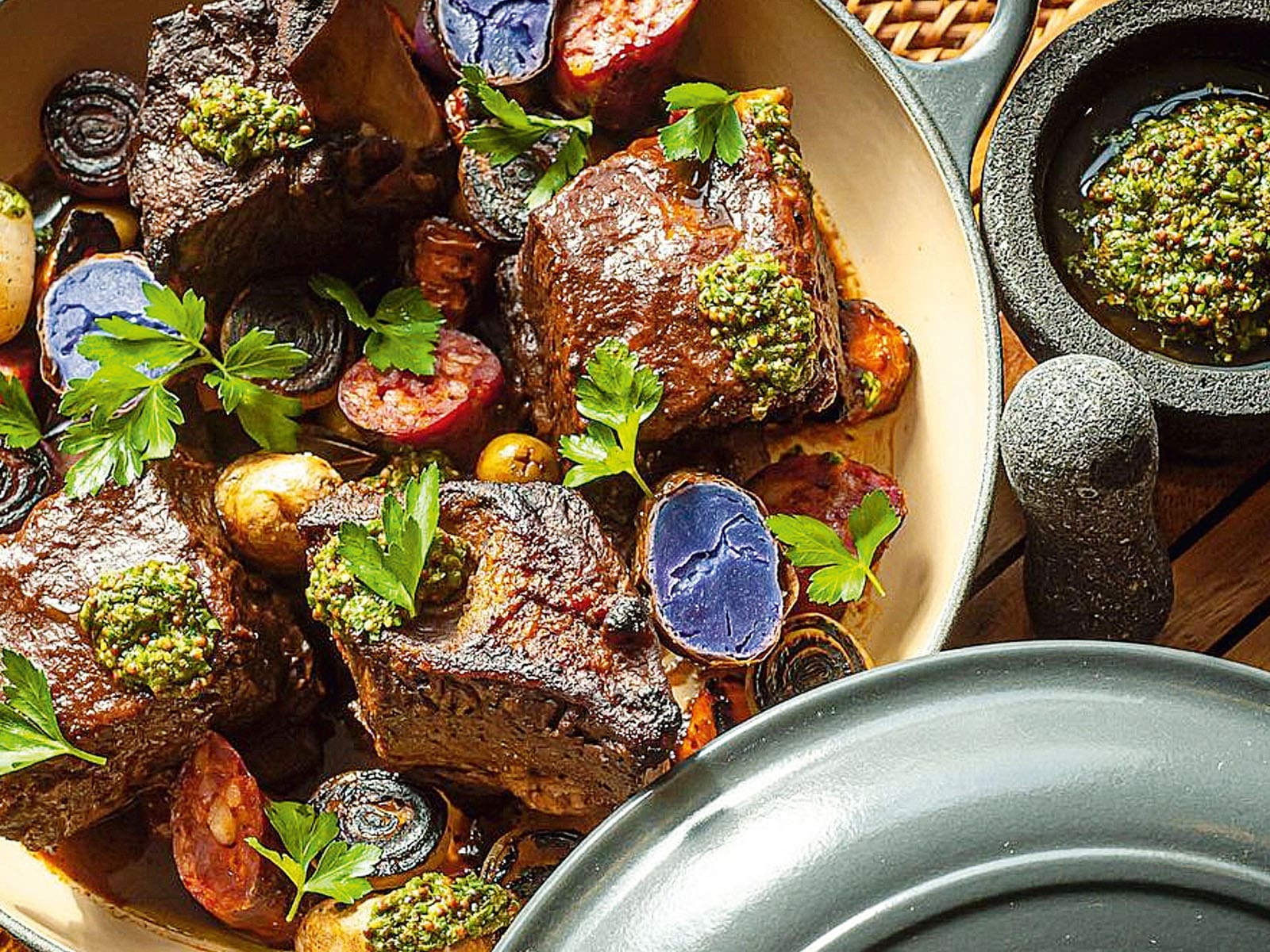Photographed by Martin Romero.
The Chicago hotspot is the first Michelin-starred Filipino restaurant.
Everyone has a story to tell about March 2020—where they were, what they were doing, how their plans got derailed when the entire world shut down. For chef Timothy Flores and his partner, pastry chef Genie Kwon, fate seemed particularly cruel. They’d just passed city inspections and received their business license for Kasama, the bakery and modern Filipino restaurant they had envisioned opening in Chicago, when all dining establishments were ordered to close for two weeks.
In the face of extraordinary uncertainty, without knowing how long the pandemic would last and how long it would take for the industry to recover, Flores and Kwon soldiered on in the pursuit of a long-held dream. Building the restaurant during the pandemic was certainly anything but ideal, but it was still, on some level, a blank slate. Like any chef worth their salt, they could improvise.
Pivoting to a takeout-only business had the unexpected benefit of simplifying a few elements of the process. “We didn’t spend money on tables or chairs since we had no idea when we’d actually be able to serve guests indoors,” Flores says. They found themselves buying gloves instead of glassware, plexiglass barriers instead of plates. In the worst of times, the silver lining remained: “We always tried to keep our heads up despite the situation, because we were still doing something that we love.”
It’s his determination that has constantly seen him through, even as he took a circuitous path to becoming a chef. Born and raised in Chicago to first-generation Filipino immigrants, Flores grew up with both of his parents working full-time jobs. He learned to cook at an early age by necessity, which kindled a lifelong interest in food. Culinary school, however, didn’t seem practical. He opted to pursue communication design and business instead, but as a college junior, he found himself taking on a part-time job polishing dishes at a restaurant. He worked his way up to bussing tables, and after realizing how much he enjoyed the restaurant environment, he asked if he could try his hand at cooking professionally.

He met Kwon at GT Fish & Oyster—she was starting out as the pastry chef; he was leaving to pursue other opportunities after having worked there for three years. Sometime later, the two reconnected through a mutual friend. “I asked her if I could kind of intern with her, because I wanted to learn pastry,” Flores recalls. “We started hanging out from there, and we ended up living together and working together.” In 2016, they were both part of the opening team at Oriole, a contemporary American restaurant under Noah Sandoval that earned two Michelin stars the same year it opened.
Having spent years cooking in some of Chicago’s most renowned restaurants, Flores and Kwon wanted to embark on their next chapter: opening a place of their own. As they began shaping their vision of what their first independent restaurant would be, Filipino cuisine wasn’t initially on the table. “I thought maybe I might use Filipino ingredients or [be inspired by] Filipino dishes,” he says. “But when we were finalizing our concept, I was asking myself, what do I want to cook? It just came down to cooking the food I grew up eating—my mom’s cooking.”
Flores and Kwon decided it would be a casual bakery-restaurant by day that transitioned to a more refined dinner venue at night. The restaurant’s name was chosen to represent how their two concepts came together: Kasama, a venture rooted in their personal and professional partnership. The logo features a rising sun and a setting sun, an allusion to Kwon’s daytime bakery and Flores’s nighttime menu.
Now it was so close to becoming real, with one looming obstacle: a global pandemic. On top of everything else that came with trying to get a new restaurant up and running, the first few months of dealing with COVID restrictions were a haze of confusion and doubt. “We were so unsure of what was going on and how to treat every situation.”
Against all odds, Kasama opened in July. On the takeout menu were adobo chicken wings, barbecued pork skewers with charred corn, Filipino breakfast silog [fried egg-paired viands], lumpia, and Kwon’s now legendary ube huckleberry Basque cakes. There were long lines and the warmest of welcomes; they sold out of everything on their first day.
It was a good summer with a bustling takeout business, growing buzz, and media attention. They took full advantage of their patio for al fresco dining. As the seasons changed, however, running the restaurant became increasingly difficult.
That winter, with rising costs and strict capacity restrictions for indoor dining, it became apparent that they needed to make another pandemic pivot. Flores and Kwon’s backgrounds were both in fine dining, but at Kasama, they’d chosen to veer from it in order to make their restaurant—and by association, Filipino cuisine—more accessible. “We never thought about doing a tasting menu,” he says. Yet, even if it wasn’t part of the plan (the pandemic had made it clear that it didn’t care about anyone’s plans), a tasting menu with a limited number of guests made business sense: it would enable them to keep the restaurant running, pay their staff fairly, and share more of the modern Filipino food that Kasama was becoming known for.
Flores now faced the challenge of reimagining the food he grew up with through a new lens. The ethos was preserving those familiar, beloved flavors and interpreting them in a unique form or with unexpected ingredients—and at the same time, defying perceptions of what Filipino food can or should be.
He drew from memories of home and his mother’s cooking. A tasting menu is, in essence, a narrative in culinary form. In 13 courses—Flores considers 13 to be his lucky number; it’s his birthdate, and his father grew up on Barretto Street in Olongapo—Kasama tells an extraordinary story, infusing the dishes of Flores’ childhood with the creativity, skill, and technique he’s honed in some of the best restaurants in Chicago.

Flores renders Filipino cooking with a style and confidence seldom seen or associated with the cuisine in America. Adobo makes an expected appearance, but not quite as you know it: maitake mushrooms and scallops in a soy-vinegar sauce, given further depth with a mussel emulsion. Inasal is here as well (true to form, served on a banana leaf-adorned plate), but with squab instead of chicken, accompanied with a foie gras mousse. For guests familiar with the cuisine, it’s an opportunity to see it with new eyes. For others enjoying Filipino food for the first time, it’s a glorious introduction.
One of the clear highlights is a modern take on nilaga, a stew that has become the paragon of Filipino home cooking. “It was one of those dishes that we ate a lot growing up, but it wasn’t something that I enjoyed because we had it so often,” Flores shares. “It was very boring to me as a child, just plain soup with beef and cabbage and potatoes. But as I got older, it became one of the most satisfying meals that I could really enjoy.”
Kasama’s adaptation begins with cooking Savoy cabbage in beef fat and bone marrow. The cabbage joins thinly sliced A5 wagyu beef over a bed of short-grain rice, the entire bowl lightly torched just before serving. A ceramic teacup holds the broth on the side; both bowl and cup sitting on a wooden tray, plated in a way that feels almost Japanese in its artistic restraint. It is simple, focused, sublime.
Guests are encouraged to take sips of the broth in between spoonfuls of the rice. The deconstruction of the dish is an homage to Flores’s father, who prefers eating nilaga this way. “My dad didn’t like the sabaw [soup] in his rice, so he would drink the broth on the side. I always remember him scooping out the bone marrow from the soup and mixing it into the rice.”
Knowing how opinionated Filipinos can be about our own cuisine, and how stubbornly we tend to cling to ideas of how certain dishes should be made or enjoyed, Flores was apprehensive about how his cooking would be received. “We’re such a proud culture,” he says. “How do we keep those traditions and flavors, but at the same time make it more accessible for everybody? When we first opened, I think there was a little bit of skepticism around seeing Filipino food in a different way and in a different atmosphere, but overall, we received a huge amount of support from the Filipino community.” In particular, Flores is amazed to have guests who go out of their way to eat at Kasama when they’re visiting from the Philippines. “They’re coming to eat at a Filipino restaurant in Chicago versus Midwest classics or what the city is known for. That’s pretty cool.”
It is clear that while Flores is traversing a familiar path, he is blazing his own trail. Five months after launching their tasting menu, Kasama was awarded a Michelin star, making it the only Filipino restaurant in the world to receive this distinction. It took Flores and Kwon by such surprise that they missed the call meant to share the good news with them. “It hadn’t even been half a year, and to be included in the Michelin guide was kind of insane for us, especially because this tasting menu was a product of the pandemic.”
For Flores, the rarity of this recognition for Filipino cooking is something that continually motivates him. “We have so many guests who get emotional during the meal and even begin to cry, because they’re eating at a fine dining restaurant that has a Michelin star. And they’re eating the food they grew up eating,” he says. He knows cuisines like ours usually face a double standard, considered unable to command a certain price or deemed comparatively unworthy of industry acclaim. He relishes the opportunity to challenge these tired, outdated notions. “We spend money on French, Italian, Japanese tasting menus. Why can’t we do it with our own cuisine?”

It means something deeper and more personal to him as well—the validation of years of hard work and the value of pursuing what might have been, at least to some, an unorthodox career path. “Food is so important in Filipino culture, but it’s not seen as a career that you should go into. It’s been something I’ve had to overcome,” he says. “Throughout my cooking career, my dad would always tell me that I should utilize my degree and that I should get a job. In my head, I always knew that this is what I wanted to do. But it takes a long time to really get there, to be successful at this. It’s a difficult business.”
Last June, Flores and Kwon were awarded Best Chefs for the Great Lakes region by the James Beard Foundation, the industry’s highest honor. Dressed in matching emerald green suits, they took to the stage, overwhelmed with emotion. Kwon, wiping tears from her eyes, thanked their team, their partners, their guests, their families—and their puppy Longganisa. When it was Flores’s turn at the podium, he told the audience that he never thought he’d be cooking Filipino food professionally until they opened Kasama. “To be recognized for cooking my mom’s food is insane. My parents are in the Philippines right now, on a beach somewhere, drinking out of a coconut while I stand on this stage on the verge of shitting my pants.”
A new breed of Filipino-American creatives, Flores included, is reclaiming their stories and coming into their own. “The cool part for me is seeing Filipinos, not just in America but around the world, doing really amazing things. I think there’s a lot of first- or second-generation Filipinos who have decided, maybe they want to go into art, or music, or cooking. Right about this time is when we have those opportunities to explore it on our own. We’ve put in the time to make it this far.”
In a full-circle moment, the East Ukrainian neighborhood Kasama calls home in Chicago is where Flores’s mother and father both lived when they each immigrated to America in December 1975. “They didn’t know each other then, but they met here in Chicago, in this neighborhood,” Flores says, humbled by the idea of having a Filipino restaurant where his parents originally lived as immigrants from the Philippines. In many ways, Kasama is a homecoming for him, a bridge connecting past and future. It is a celebration of duality: of food and memory, of identity, of Flores and Kwon’s partnership. Here is where they coalesce, becoming greater than the sum of their parts. It all comes together beautifully, seamlessly, here at Kasama.

